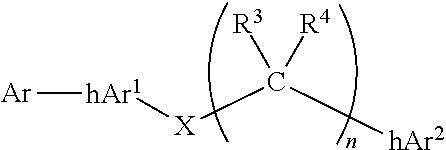Compounds comprising linked heteroaryl moieties and their use as novel umami flavor modifiers, tastants and taste enhancers for comestible compositions
a technology of msg and heteroaryl moieties, applied in the field of flavor or taste modifiers, can solve the problems of poor understanding of the biochemical basis of taste perception, inability to identify artificial substitutes for msg, and adverse reactions of msg in some people, so as to enhance savory taste perception and increase or modulate the response
- Summary
- Abstract
- Description
- Claims
- Application Information
AI Technical Summary
Benefits of technology
Problems solved by technology
Method used
Image
Examples
example 1
2-((5-(2-methoxy-4-methylphenyl)-1H-1,2,4-triazol-3-ylthio)methyl)pyridine
[0472]
[0473]To a solution of 5-(2-methoxy-4-methylphenyl)-2H-1,2,4-triazole-3(4H)-thione (Example 1a) (110 mg, 0.5 mmol) in 2 ml of EtOH was added 2-(bromomethyl)pyridine hydrobromide (152 mg, 0.6 mmol). The suspension was heated at 60° C. for 22 h. The reaction was diluted with EtOAc and washed with water, brine, dried over MgSO4 filtered and evaporated to produce an oil. The oil was purified on a preparative TLC plate to produce the desired product (72%). 1H NMR (500 MHz, CDCl3): δ 2.40 (s, 3H), 3.99 (s, 3H), 4.55 (s, 2H), 6.84 (s, 1H), 6.92-6.93 (d, 1H), 7.16-7.19 (dd, 1H), 7.53-7.55 (d, 1H), 7.62-7.65 (m, 1H), 8.15-8.17 (d, 1H), 8.56-8.57 (d, 1H). MS (M+H, 313).
[0474]The compound had EC50 for activation of a hT1R1 / hT1R3 umami receptor expressed in an HEK293 cell line of 0.08 μM, and when present at 0.03 μM enhanced the effectiveness of monosodium glutamate with an EC50 ratio of 5.9.
example 1a
5-(2-methoxy-4-methylphenyl)-2H-1,2,4-triazole-3(4H)-thione
[0475]To a solution of 2-methoxy-4-methylbenzoic acid (1.81 g, 9.22 mmol) in 9 ml of pyridine was added EDCI (1.9 g, 9.3 mmol) and the suspension was stirred at r.t. for 1 h. Then thiosemicarbazide (800 mg, 8.8 mmol) was added and the reaction was stirred at r.t. for 21 h. The mixture was evaporated to dryness and then diluted with water. The white solid was then filtered, washed with water and suspended in 20 ml 1 M aq. NaHCO3 and then heated at reflux for 2 days. The suspension was filtered hot and the aqueous solution was cooled in ice and acidified to pH 3 with conc. HCl. The solid was filtered and washed with water and dried to give a white powder (47%).
example 2
2-((5-(2-methoxy-4-methylphenyl)-1H-1,2,4-triazol-3-ylthio)methyl)-5-methylpyridine
[0476]
[0477]Prepared in a similar manner to example 1 using 5-(2-methoxy-4-methylphenyl)-2H-1,2,4-triazole-3(4H)-thione (example 1a) and 2-(chloromethyl)-5-methylpyridine (example 2a). Yield 14%. 1H NMR (500 MHz, CDCl3): δ2.29 (s, 3H), 2.41 (s, 3H), 4.00 (s, 3H), 4.51 (s, 2H), 6.75 (s, 1H), 6.90 (s, 1H), 7.40 (s, 1H), 8.1 (d, 1H), 8.4 (s, 1H), 11.5-11.7 (bs, 1H). MS (M+H, 327.1).
[0478]The compound had EC50 for activation of a hT1R1 / hT1R3 umami receptor expressed in an HEK293 cell line of 0.49 μM.
PUM
 Login to View More
Login to View More Abstract
Description
Claims
Application Information
 Login to View More
Login to View More - R&D
- Intellectual Property
- Life Sciences
- Materials
- Tech Scout
- Unparalleled Data Quality
- Higher Quality Content
- 60% Fewer Hallucinations
Browse by: Latest US Patents, China's latest patents, Technical Efficacy Thesaurus, Application Domain, Technology Topic, Popular Technical Reports.
© 2025 PatSnap. All rights reserved.Legal|Privacy policy|Modern Slavery Act Transparency Statement|Sitemap|About US| Contact US: help@patsnap.com



